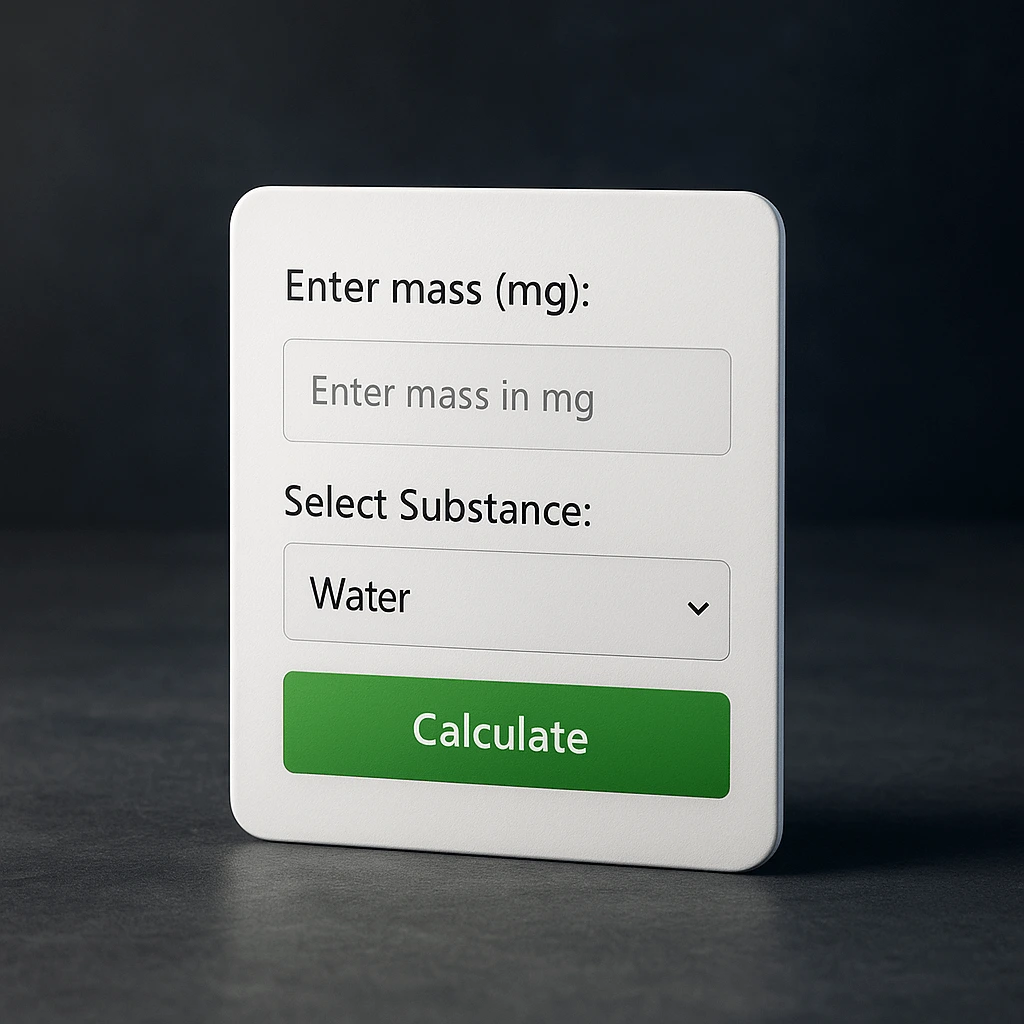mg to mL Calculator
Convert milligrams to milliliters effortlessly with our mg to ml calculator. Your go-to mg/ml converter for chemistry, cooking, and beyond. Paste your values and get precise mg to ml conversion in seconds!
What’s a Milligram?
A milligram is a unit of mass in the Metric System. The symbol for milligram is mg.
What’s a Milliliter?
A milliliter is a metric unit of volume equal to a thousandth of a liter.
Why Mg to mL Conversion Matters
First things first, let’s break down why converting milligrams (mg) to milliliters (mL) is so important. Whether you’re preparing a precise solution for a lab experiment or following a recipe that requires exact measurements, getting the conversion right is crucial. Imagine you’re working on a delicate chemical reaction, and you need to add a specific amount of a reagent. If you miscalculate, it could throw off the entire experiment. Similarly, in cooking, a slight error in measurements can lead to a dish that’s not quite right.
The Science Behind the Conversion
Before we dive into the tool itself, let’s quickly cover the science behind converting mass to volume. This mg/ml conversion is based on the density of the substance you’re working with. Density is defined as mass per unit volume, and it varies depending on the material. For example, water has a density of approximately 1 gram per milliliter (g/mL). This means that 1 milligram of water is equivalent to 0.001 milliliters.
Here’s the mg/ml formula to remember:
What is Density (mg/mL)?
Density expresses mass per volume (mg/mL). For instance, water = 1 g/mL (or 1000 mg/mL), olive oil = 916 mg/mL, glycerin = 1260 mg/mL.
| Substance | Density (mg/mL) |
|---|---|
| Water | 1000 |
| Olive Oil | 916 |
| Glycerin | 1260 |
How to Use the mg to ml Calculator
Using this calculator is a breeze. Here’s a step-by-step guide to help you get started:
Head over to: https://molaritycalc.com/milligram-to-milliliter/
Enter Your Values: Type in the amount in milligrams, then pick the substance from the dropdown list. Notice that to reverse the conversion from ml to mg, choose the mode of volume to mass.
Get Your Results: Click the “Calculate” button, and voilà! You’ll get the volume in milliliters.

Examples of mg to ml Conversion
Let’s look at a couple of real-life examples of mg to ml conversion to see how this tool can be incredibly useful.
Example 1: Converting Medicine Dosage
A doctor prescribes 500mg of a medication. The medicine’s concentration is 25mg/ml. How many ml should you take? Using our calculator, you simply enter 500mg and select the medication or input the concentration of 25mg/ml. The result is 20ml. This precise calculation ensures you’re taking the correct dosage as prescribed.
Example 2: Converting a Cooking Ingredient
A recipe calls for 5000mg of olive oil. What is this in ml? With olive oil having a density of approximately 0.92 g/mL (or 920 mg/mL), you can use our calculator to find that 5000mg of olive oil equals approximately 5.43ml. This level of precision can make a significant difference in recipes that require exact measurements.
Example 3: Science Lab Application
You need to measure 1000mg of ethanol for an experiment. What volume in ml is required? Ethanol has a density of 0.785 g/mL (or 785 mg/mL). Using our calculator, you find that 1000mg of ethanol equals approximately 1.27ml. This accuracy is crucial in laboratory settings where precise measurements can affect experimental outcomes.
Why Choose Our mg to ml Calculator?
- ✓Supports 30+ substances with accurate densities at 25°C.
- ✓Reverse calculations (mg to mL or mL to mg).
- ✓Custom density and temperature inputs for flexibility.
- ✓Interactive bar chart visualization for comparison with water.
- ✓Data sourced from CRC Handbook of Chemistry and Physics and NIST for reliability.
Benefits of Using this Online Converter
Here are a few compelling reasons:
- Accuracy: Get precise results every time.
- Timesaving: No more manual calculations or searching through reference materials.
- User-Friendly: Simple interface makes it easy for anyone to use.
- Free: No need to pay for expensive software or apps.
Milligrams to Milliliters Conversion Table
This table provides approximate conversions from milligrams (mg) to milliliters (ml) for water and milk based on their respective densities.
| Weight in Milligrams | Volume in milliliters of Water | Volume in milliliters of Milk |
|---|---|---|
| 1 mg | 0.001 ml | 0.00097 ml |
| 10 mg | 0.01 ml | 0.0097 ml |
| 15 mg | 0.015 ml | 0.0146 ml |
| 50 mg | 0.05 ml | 0.0485 ml |
| 150 mg | 0.15 ml | 0.1456 ml |
| 400 mg | 0.4 ml | 0.3883 ml |
Conclusion
The Mg to mL Calculator is a fantastic tool that can easily convert weight to volume or vise versa, whether you’re in the lab or the kitchen. By providing quick, accurate conversions, it helps you focus on what really matters, your experiments or your culinary creations.
FAQs
To convert milligrams to milliliters, divide the mass by the density: Formula: mL = mg ÷ density (mg/mL). For water, 1000 mg = 1 mL (since density is 1000 mg/mL). Use this formula when you know the substance’s density. If you don’t, our tool will help you estimate it.
Density is the mass per unit volume (mg/mL) of a substance. It’s crucial for accurate conversion because the relationship between MG and ML varies with different substances.
No, the conversion depends on the substance’s density. For example, water (1000 mg/mL) differs from cooking oil (916 mg/mL).
To convert 100 mg to mL, divide the mass by the density. For a substance with a density of 1000 mg/mL, 100 mg ÷ 1000 mg/mL = 0.1 mL.
Yes! Just select the substance or input its density in mg/ml for accurate mg to ml conversion every time.

Spread the love. Share this calculator
